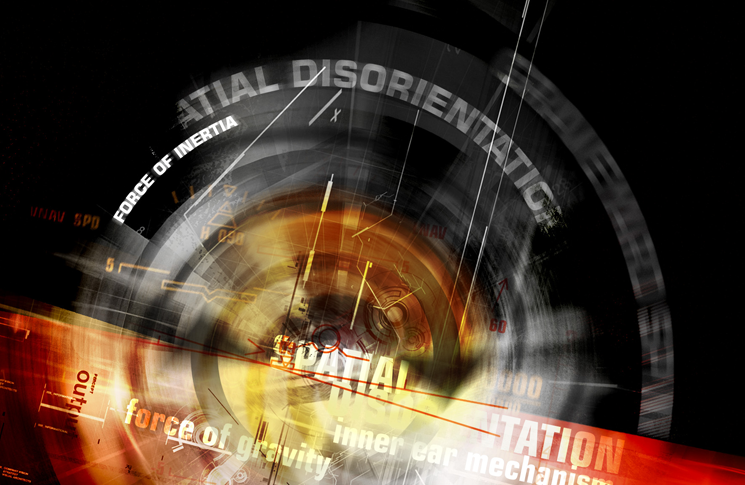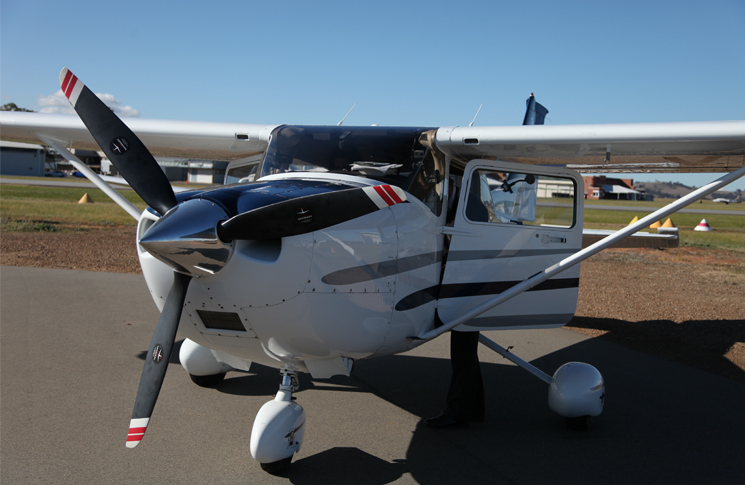by Julian Yates
I’ve tried to avoid situations that cause raised heart rates and sweaty palms while flying and have mostly achieved this. I’m pretty conservative and before gaining an instrument rating, avoided cloud by large margins and since gaining the rating, fly in generally ‘good’ instrument weather. I’m particularly conscious of the danger of the leans having had one powerful demonstration of its effects, and I wasn’t even in cloud or at night!
Several years ago, I was returning to Jandakot from a flying tour around North West WA. Our plans had the fairly ambitious goal of leaving Broome in the morning, refuelling in Meekatharra, then on to Jandakot before last light. We were travelling in a Cessna 182 with huge tanks; it wasn’t IFR but had the usual fit of instruments and aids and a basic autopilot that sort of followed the heading bug in smooth conditions. Give it any bumps and hand flying was the better choice. We did a lot of hand flying.
 So there we were, refuelled, fed and trundling south from Meeka, with a steadily lowering cloudbase. The forecast was iffy about making it through to Jandakot—VFR underneath and the cloud tops were way too high to go over. About ten minutes after overflying Mt Magnet we were down to around 1000 ft AGL and it didn’t look like it was getting better. So, we returned to Mt Magnet, called it a day, and called one of the local hotel/motels and they very kindly came out and picked us up.
So there we were, refuelled, fed and trundling south from Meeka, with a steadily lowering cloudbase. The forecast was iffy about making it through to Jandakot—VFR underneath and the cloud tops were way too high to go over. About ten minutes after overflying Mt Magnet we were down to around 1000 ft AGL and it didn’t look like it was getting better. So, we returned to Mt Magnet, called it a day, and called one of the local hotel/motels and they very kindly came out and picked us up.
The next day was a write off weather-wise—one look at the forecast and I told the team we’d be enjoying Mt Magnet for another day. Everyone was cool with this as I’d briefed them at the outset to expect delays.
The following day’s forecast was more promising. The low cloud and strong winds had gone and while there was a lot of broken cloud up to 8000 ft, the base was expected to provide at least 1500 ft AGL clearance. The decision was to go. We had plenty of fuel and expected to be past the cloud by Ballidu (a small town with a VOR/NDB back then). The first twenty minutes went as expected but we were again being pushed down to 1000 ft AGL with rising ground approaching. The cloud was broken stratocumulus/cumulus, but with large holes. By large, I mean 5 nm or more long and 3–4 nm wide! Not tight little gaps and there were plenty of them. As I could use the navaids for tracking above cloud, I decided it would be better to climb up through one of the breaks and continue VMC on top. I’d been able to confirm from other pilots that the cloud did break up at Ballidu, about 80 nm south of us.
So, I put the C182 into the climb and started up, using a holding pattern-type racetrack to stay well clear of cloud. The first turn or two round the racetrack went just fine. Good rate of climb, well clear of cloud, 2- to 3-minute legs and so on.
The trouble began as we started to get a horizon from the edges of the cloud tops—the cloud horizon was sloped! Only ten or so degrees off horizontal, but I was finding it increasingly difficult to fly straight and level! My eyes wanted me to be in a bank—it felt like we were still in a turn when we were straight and so on. I was acutely aware of being affected by the leans and it was a struggle to keep things comfortably under control! I tried switching from being on the instruments to looking out the window—I desperately didn’t want to enter cloud and put that as the highest priority. This just didn’t work! I’d get sort of settled on the instruments then look out to avoid the cloud and the leans would be on again. Not at all nice!
We staggered on around another circuit, or so it seemed to me (my passengers didn’t notice, so it may not have been as bad as it felt to me!) with an increasing level of personal disquiet. Finally, I recalled the autopilot and flipped it on to wings level then heading mode (attitude was distinctly manual till you reached cruising level). What an amazing difference! The leans and stresses basically vanished within seconds. I was easily able to complete the next circuit visually and get above the cloud where we were able to continue on top and head for the Ballidu VOR. The cloud dissipated south of Ballidu and we continued to Jandakot without any further issues.
So, what did I learn from this? Here are my thoughts:
- The leans are real, powerful and can occur in VMC especially where there is a sloping horizon.
- You must fly either on the instruments or visually—switching between both can make things worse. If there is much white stuff about now, I go IFR (assuming the aircraft can).
- Large holes in clouds can be dangerous, even if you remain clear of the white stuff.
- Use the autopilot! In many circumstances it can free up the pilot for critical tasks.
- Plan trips with plenty of slack and ensure passengers know that delays are normal (on this trip, I wasn’t under any pressure to go).
My flying aims remain a normal heartrate and dry palms!



Yes, i have experience the same.
Some years ago I was caught in an almost identical situation, in the same bit of sky, returning to Jandakot from Newman.
Cloud horizons are notoriously disorientating because they create a mental conflict between the pilots visual observations, and the instrument inputs, especially the artificial horizon. I fully endorse the authors comments that you must be either VFR in VMC, or completely IFR.
Like wives and Mistresses, never the twain should meet.
Geez Walter ease up buddy ! We can’t all be the perfect pilot you profess to be. People like you give me the shits !!
What did you learn from this? Not much you where way behind the A/C! You are either visual or IMC, pick one ! Use the bloody A/P, it was sitting there saying dumb dumb dumb!
I hope it frightened the crap out of you & you learned a valuable lesson, it’s the pax I feel sorry for not you !
People learn by their own and in forums like this others mistakes, perfect people like you! Are the most Dangerous!
Walter’s likely responses are well known by the regulars here …most of us encourage personal safety related stories to learn something. Still… an opposing viewpoint can also be valuable ..albeit personally unpleasant ..Contributors will get no sympathy from some commentators here..
Thanks Yulian for sharing. I highly respect these warning stories experienced. Any pilot that things he is beyond learning and never gets caught out is fooling himself.
Great article, thank you Julian for sharing this flight.. I am always grateful to read other pilots experiences and the lessons learnt.